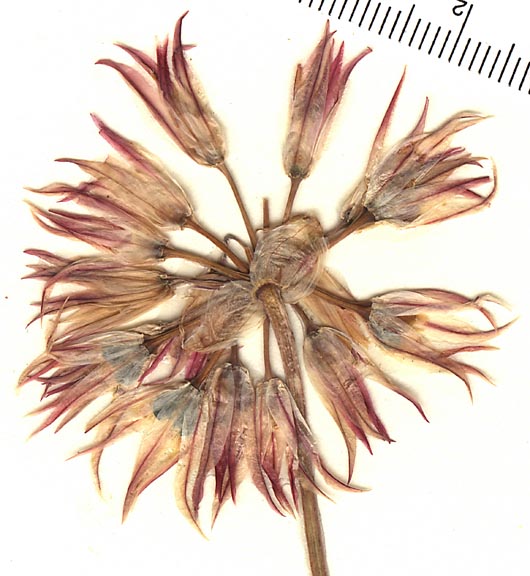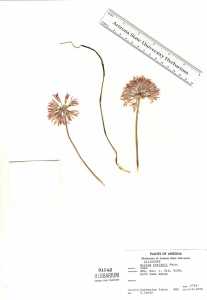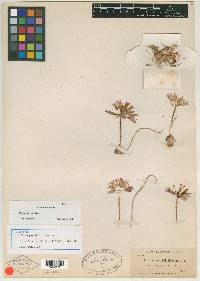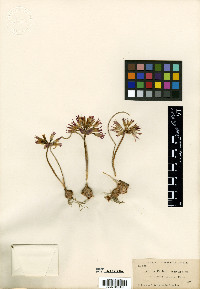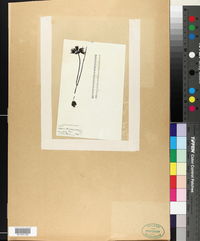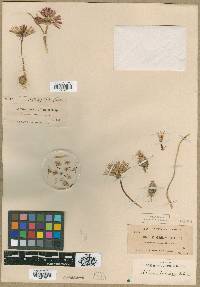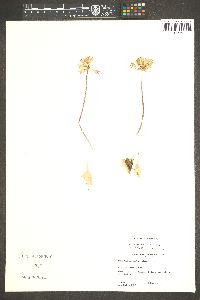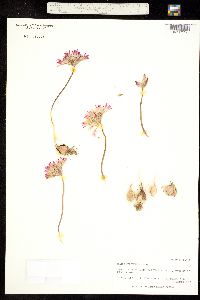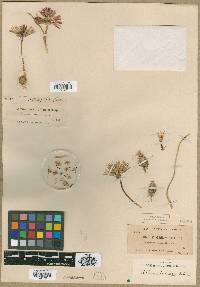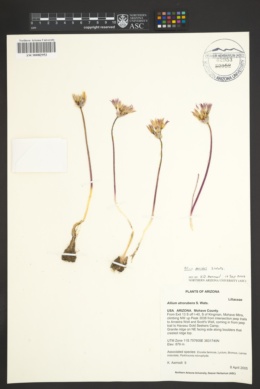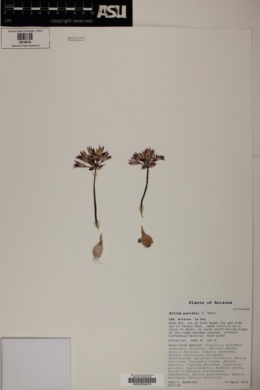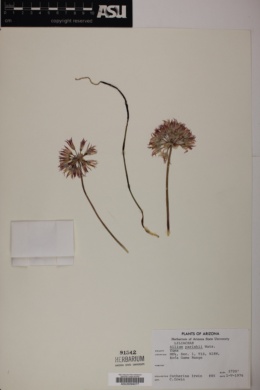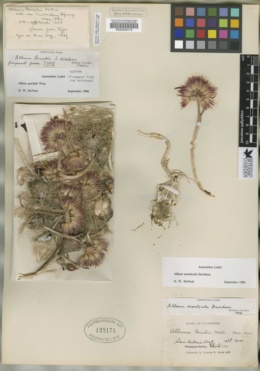Allium parishii
|
|
|
|
Family: Amaryllidaceae
Parish's Onion
|
Bulbs 1-2, not clustered on primary rhizome, without stalked basal increase bulbs, ovoid, 1-1.5 × 0.8-1.3 cm; outer coats enclosing bulbs, brown to reddish brown, membranous, lacking cellular reticulation or cells arranged in only 2-3 rows distal to roots, ± quadrate, without fibers; inner coats pinkish to reddish brown, cells obscure, ± rectangular, vertically elongate. Leaves persistent, withering from tip by anthesis, 1, basally sheathing, sheath not extending much above soil level; blade solid, terete, 5-30 cm × 1-3 mm. Scape persistent, solitary, erect, solid, terete, 5-25 cm × 1-3 mm. Umbel persistent, erect, compact, 6-15-flowered, hemispheric, bulbils unknown; spathe bracts persistent, 2-3, 5-7-veined, ovate, ± equal, apex acuminate. Flowers narrowly campanulate, 12-18 mm; tepals erect, spreading at tips, pale pink with darker midveins, lanceolate to lance-linear, ± equal, inner slightly shorter and narrower than outer, margins entire, apex acute, becoming rigid in fruit; stamens included; anthers yellow; pollen yellow; ovary crested; processes 6, prominent, ± triangular, margins entire to irregularly denticulate; style linear, equaling stamens; stigma capitate, scarcely thickened, minutely 3-lobed, lobes stout, ± spreading; pedicel 5-15 mm. Seed coat dull or shining; cells minutely roughened. 2n = 14. Flowering Apr--May. Rocky, sandy desert slopes; 900--1400 m; Ariz., Calif. FNA 2003, McNeal 2014 (Jepson) Duration: Perennial Nativity: Native Lifeform: Forb/Herb General: Perennial scapose herb from an ovoid bulb; bulbs solitary or paired, not clustered, 1-1.5 cm high, with a red-brown, membranous outer coat and a pinkish to red-brown inner coat. Leaves: Solitary, persistent, and withering from the tip by anthesis, with a basal sheath not extending much above soil level; blade solid, round in cross section, 5-30 cm long and 1-3 mm thick. Flowers: Bright pink, arranged in an umbel at the tip of a solitary erect scape, this 5-25 cm long; umbel compact, 6-15-flowered, hemispheric, with 2-3 spathe bracts, these persistent, 5-7-veined, ovate with acuminate tips; pedicels short and stout, shorter than the flowers; flowers narrowly campanulate, 12-18 mm high, with 6 erect tepals, these lanceolate and spreading at tips, pink with darker midveins, becoming rigid in fruit. Fruits: Ovary with 6 crests, these entire or finely and irregularly dentate; seed coat dull or shining. Ecology: Found on rocky, sandy desert slopes, from 3,000-4,500 ft (914--1372 m) flowers April-May. Distribution: w AZ, se CA Notes: This rare onion has a quite limited range, being known from scattered populations in the desert mountains along the AZ-CA border, and west through Joshua Tree National Park to the San Bernardino Mountains. Look for pink, 6-petaled flowers on pedicels that are short and stout, mostly shorter than the flowers; one short scape (flower stalk) per plant, usually only a few inches high; a single leaf per plant; and an onion odor (if it doesn-t smell like onion or garlic, it-s not an Allium!) When you dig up the bulb you-ll see a membranous coating around the bulb but no fibers. Allium macropetalum is an onion commonly found in desert habitats, including the mountains along the AZ-CA border; it differs from A. parishii by having fibrous coats on its bulbs, and lighter pink, almost white flower petals with darker pink veins. A. nevadense could also occur in similar habitats; it also has pale pink to white petals, and long, slender pedicels which are longer than the flowers. Ethnobotany: Unknown, but many other species in the genus are commonly eaten. Etymology: Allium is Latin for garlic; parishii honors brothers Samuel Bonsall Parish (1838-1928) and William Fletcher Parish (1840-1918,) both botanical collectors who lived in San Bernardino, California. Synonyms: None Editor: AHazelton 2015 |

